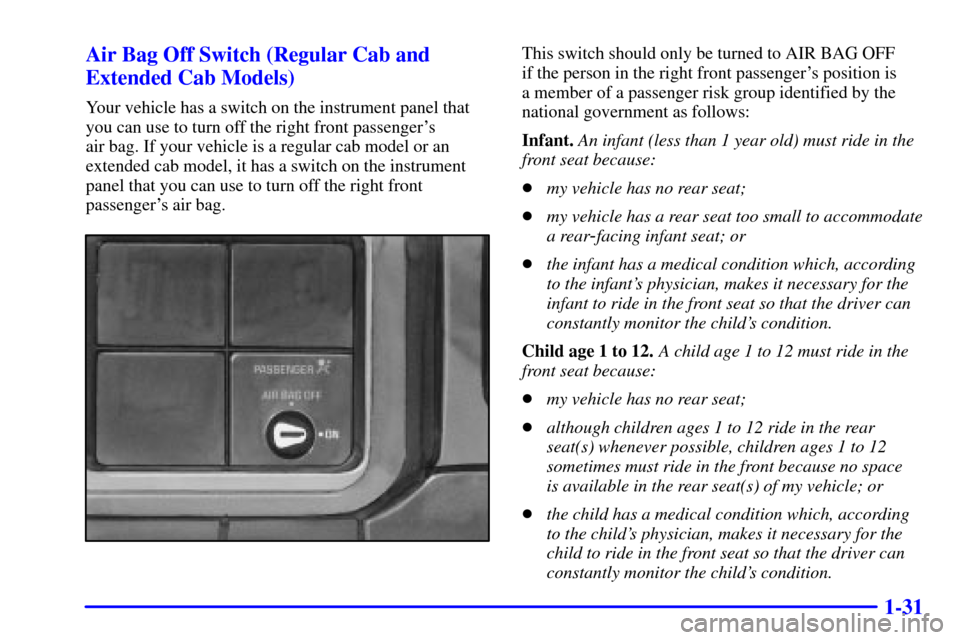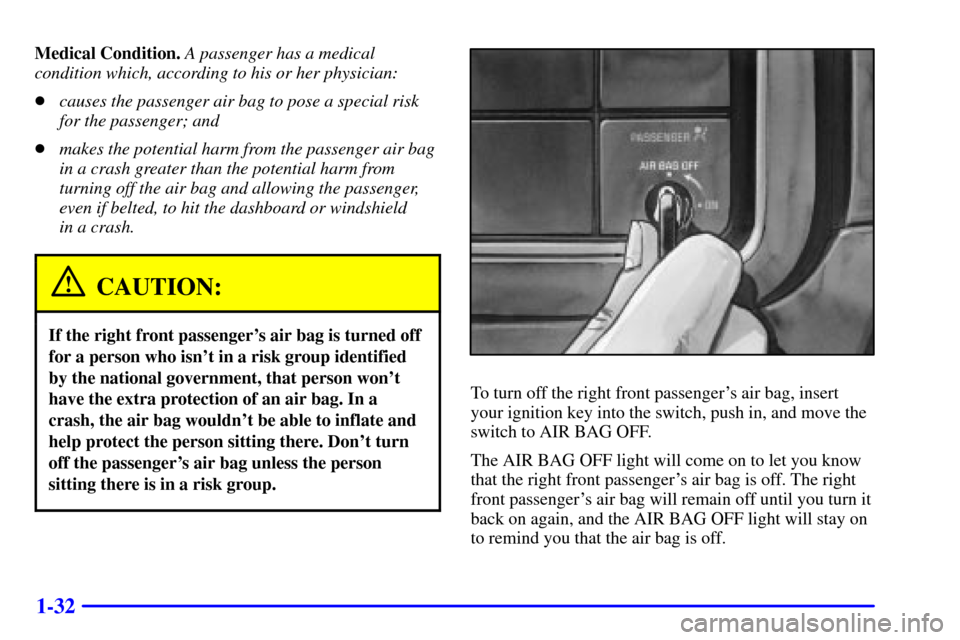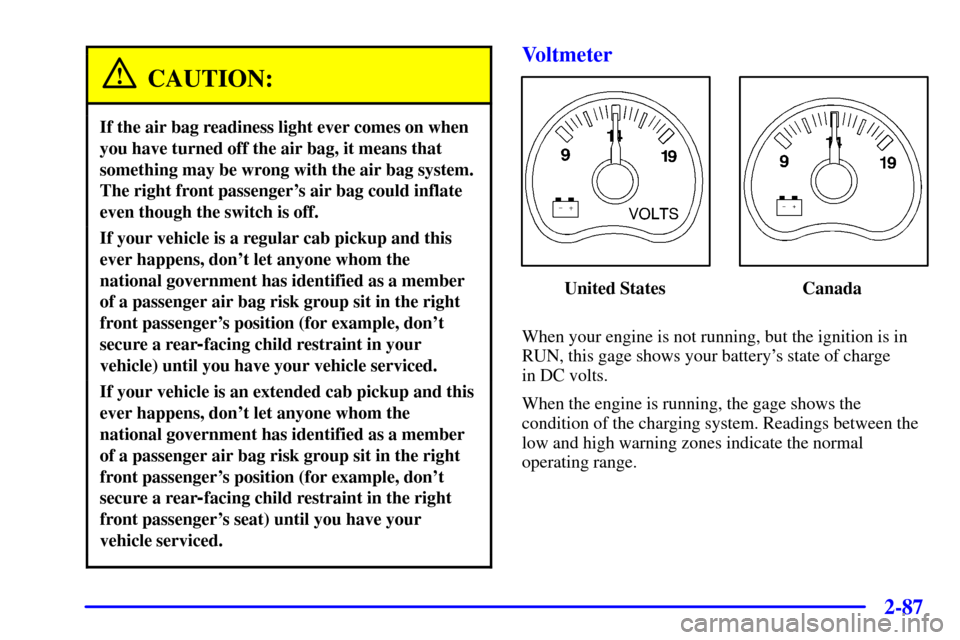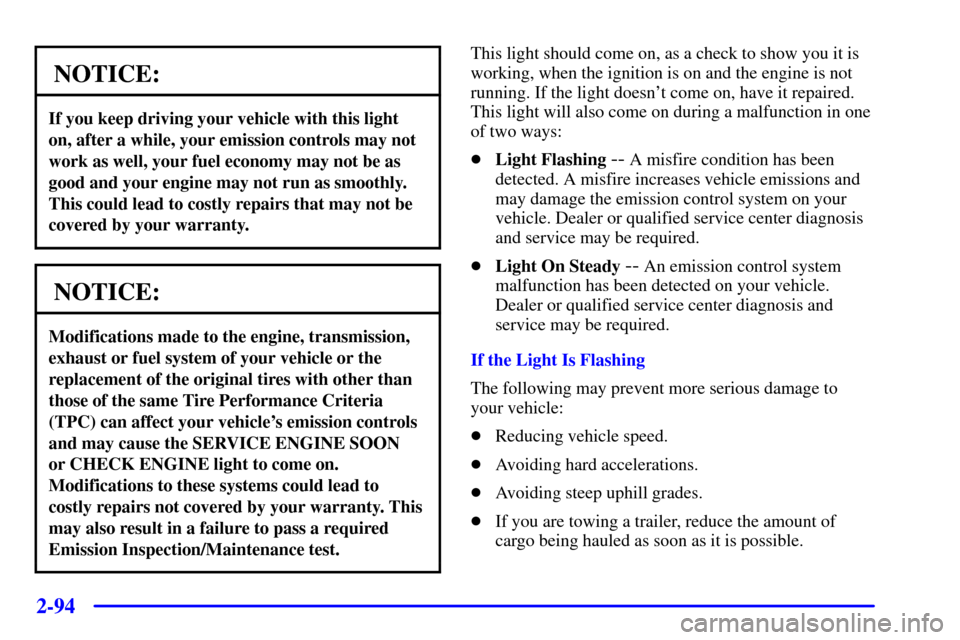Page 5 of 468
iii
Section
3
Comfort Controls and Audio Systems
Section
4
Your Driving and the Road
Section
5
Table of Contents (cont'd)
Your Driving, the Road and Your Vehicle
Defensive Driving
Drunken Driving
Control of a Vehicle
Braking
SteeringDriving Tips for Various Road Conditions
Off-Road Driving
Recreational Vehicle Towing
Loading Your Vehicle
Towing a Trailer Heating and Air Conditioning
Setting the Radio ClockRadio/Cassette Player/CD Player
Radio Theft-Deterrent Feature (If Equipped)
Hazard Warning Flashers
Jump Starting
Towing Your VehicleEngine Overheating
Changing a Flat Tire
If You're Stuck
Problems on the Road
Page 41 of 468

1-28
CAUTION:
If something is between an occupant and an
air bag, the bag might not inflate properly or
it might force the object into that person.
The path of an inflating air bag must be kept
clear. Don't put anything between an occupant
and an air bag, and don't attach or put anything
on the steering wheel hub or on or near any
other air bag covering.
When should an air bag inflate?
An air bag is designed to inflate in a moderate to severe
frontal or near
-frontal crash. The air bag will inflate
only if the impact speed is above the system's designed
ªthreshold level.º If your vehicle goes straight into a
wall that doesn't move or deform, the threshold level is
about 9 to 16 mph (14 to 26 km/h). The threshold level can vary, however, with specific
vehicle design, so that it can be somewhat above or
below this range. If your vehicle strikes something
that will move or deform, such as a parked car,
the threshold level will be higher. The air bag is not
designed to inflate in rollovers, side impacts or rear
impacts, because inflation would not help the occupant.
In any particular crash, no one can say whether an air
bag should have inflated simply because of the damage
to a vehicle or because of what the repair costs were.
Inflation is determined by the angle of the impact
and how quickly the vehicle slows down in frontal or
near
-frontal impacts.
The air bag system is designed to work properly under
a wide range of conditions, including off
-road usage.
Observe safe driving speeds, especially on rough terrain.
As always, wear your safety belt. See ªOff
-Road
Drivingº in the Index for more tips on off
-road driving.
Page 44 of 468

1-31 Air Bag Off Switch (Regular Cab and
Extended Cab Models)
Your vehicle has a switch on the instrument panel that
you can use to turn off the right front passenger's
air bag. If your vehicle is a regular cab model or an
extended cab model, it has a switch on the instrument
panel that you can use to turn off the right front
passenger's air bag.
This switch should only be turned to AIR BAG OFF
if the person in the right front passenger's position is
a member of a passenger risk group identified by the
national government as follows:
Infant. An infant (less than 1 year old) must ride in the
front seat because:
�my vehicle has no rear seat;
�my vehicle has a rear seat too small to accommodate
a rear
-facing infant seat; or
�the infant has a medical condition which, according
to the infant's physician, makes it necessary for the
infant to ride in the front seat so that the driver can
constantly monitor the child's condition.
Child age 1 to 12.
A child age 1 to 12 must ride in the
front seat because:
�my vehicle has no rear seat;
�although children ages 1 to 12 ride in the rear
seat(s) whenever possible, children ages 1 to 12
sometimes must ride in the front because no space
is available in the rear seat(s) of my vehicle; or
�the child has a medical condition which, according
to the child's physician, makes it necessary for the
child to ride in the front seat so that the driver can
constantly monitor the child's condition.
Page 45 of 468

1-32
Medical Condition. A passenger has a medical
condition which, according to his or her physician:
�causes the passenger air bag to pose a special risk
for the passenger; and
�makes the potential harm from the passenger air bag
in a crash greater than the potential harm from
turning off the air bag and allowing the passenger,
even if belted, to hit the dashboard or windshield
in a crash.
CAUTION:
If the right front passenger's air bag is turned off
for a person who isn't in a risk group identified
by the national government, that person won't
have the extra protection of an air bag. In a
crash, the air bag wouldn't be able to inflate and
help protect the person sitting there. Don't turn
off the passenger's air bag unless the person
sitting there is in a risk group.
To turn off the right front passenger's air bag, insert
your ignition key into the switch, push in, and move the
switch to AIR BAG OFF.
The AIR BAG OFF light will come on to let you know
that the right front passenger's air bag is off. The right
front passenger's air bag will remain off until you turn it
back on again, and the AIR BAG OFF light will stay on
to remind you that the air bag is off.
Page 48 of 468
1-35
Q:What if I add a snow plow? Will it keep the
air bags from working properly?
A:We've designed our air bag systems to work
properly under a wide range of conditions,
including snow plowing with vehicles equipped
with the optional Snow Plow Prep Package
(RPO VYU). But don't change or defeat the
snow plow's ªtripping mechanism.º If you do,
it can damage your snow plow and your vehicle,
and it may cause an air bag inflation.
Center Passenger Position
Lap Belt
If your vehicle has front and rear bench seats, someone
can sit in the center positions.
When you sit in a center seating position, you have a
lap safety belt, which has no retractor. To make the belt
longer, tilt the latch plate and pull it along the belt.
Page 170 of 468

2-87
CAUTION:
If the air bag readiness light ever comes on when
you have turned off the air bag, it means that
something may be wrong with the air bag system.
The right front passenger's air bag could inflate
even though the switch is off.
If your vehicle is a regular cab pickup and this
ever happens, don't let anyone whom the
national government has identified as a member
of a passenger air bag risk group sit in the right
front passenger's position (for example, don't
secure a rear
-facing child restraint in your
vehicle) until you have your vehicle serviced.
If your vehicle is an extended cab pickup and this
ever happens, don't let anyone whom the
national government has identified as a member
of a passenger air bag risk group sit in the right
front passenger's position (for example, don't
secure a rear
-facing child restraint in the right
front passenger's seat) until you have your
vehicle serviced.
Voltmeter
United States Canada
When your engine is not running, but the ignition is in
RUN, this gage shows your battery's state of charge
in DC volts.
When the engine is running, the gage shows the
condition of the charging system. Readings between the
low and high warning zones indicate the normal
operating range.
Page 177 of 468

2-94
NOTICE:
If you keep driving your vehicle with this light
on, after a while, your emission controls may not
work as well, your fuel economy may not be as
good and your engine may not run as smoothly.
This could lead to costly repairs that may not be
covered by your warranty.
NOTICE:
Modifications made to the engine, transmission,
exhaust or fuel system of your vehicle or the
replacement of the original tires with other than
those of the same Tire Performance Criteria
(TPC) can affect your vehicle's emission controls
and may cause the SERVICE ENGINE SOON
or CHECK ENGINE light to come on.
Modifications to these systems could lead to
costly repairs not covered by your warranty. This
may also result in a failure to pass a required
Emission Inspection/Maintenance test.
This light should come on, as a check to show you it is
working, when the ignition is on and the engine is not
running. If the light doesn't come on, have it repaired.
This light will also come on during a malfunction in one
of two ways:
�Light Flashing
-- A misfire condition has been
detected. A misfire increases vehicle emissions and
may damage the emission control system on your
vehicle. Dealer or qualified service center diagnosis
and service may be required.
�Light On Steady
-- An emission control system
malfunction has been detected on your vehicle.
Dealer or qualified service center diagnosis and
service may be required.
If the Light Is Flashing
The following may prevent more serious damage to
your vehicle:
�Reducing vehicle speed.
�Avoiding hard accelerations.
�Avoiding steep uphill grades.
�If you are towing a trailer, reduce the amount of
cargo being hauled as soon as it is possible.
Page 182 of 468

2-99
Message Center
The message center is located on the left side of the
instrument panel cluster. It gives you important safety
and maintenance facts. When you turn the ignition on,
the entire center lights up for just a few seconds.
As needed, the message center will display one of the
following messages. The message center is capable of
alternating among different messages if needed.
Battery
If this message is displayed
when the engine is running,
you may have a problem
with your charging system.
The battery display will also stay on while the key is in
RUN until the engine is started.If the message stays on after starting the engine it could
indicate a problem with the generator drive belt, or some
other charging system problem. Have it checked right
away. Driving with this message displayed could drain
your battery.
If you must drive a short distance with this message
displayed, it helps to turn off all your accessories, such
as the radio and the air conditioner.
Trans Fluid Hot
If you have an automatic transmission, you have a
transmission temperature warning display contained in
the message center.
If the transmission fluid
temperature becomes high,
the message center will
display this message.